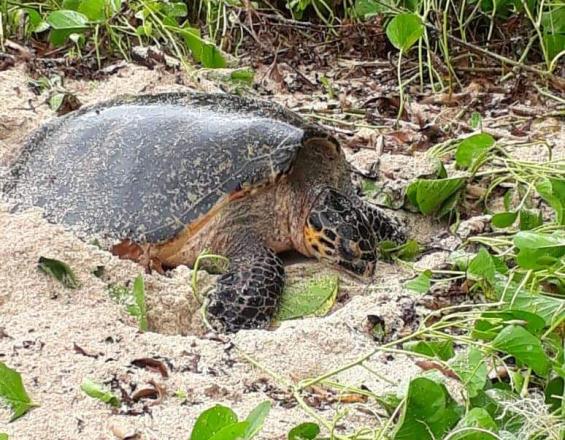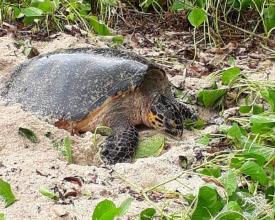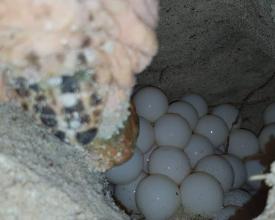Piloting Temporal Protected Areas for turtle conservation in island states: lessons from Seychelles

The implementation of Protected Areas on a seasonal basis provides protection for turtles and their off-spring during the nesting and hatching season. The Temporal Protected Area approach ensures that the turtles are not disturbed, harmed or poached during these important periods.
This initiative focuses on the protection of hawksbill turtles, as they nest seasonally, mostly on the inner islands of Seychelles. The main nesting areas in the south of Mahe, the largest and most populated island in Seychelles, have been nominated for temporary protection.
The nesting beaches are patrolled regularly with an intensified effort during the peak season to facilitate protection of the species at this critical life-cycle phase, as well recording of data from nesting turtles. Opportunistic encounters with the nesting females provide the necessary data for individual identification to better monitor their nesting behaviours.
Context
Challenges addressed
The nesting beaches are becoming more popular with frequent visits from tourists, locals having picnics and sometimes camping on the beaches. The associated noise can distress the nesting turtles, prevent successful emergence and the successful laying of eggs.
Re-planting of vegetation on some of the beaches also has its limitations. The re-planting sites are easily accessible to visitors, and unfortunately any attempt of replanting has resulted with the plants/cuttings being purposefully removed or stomped over as people make their way to the beach platform. Beach morning glory (Ipomoea) is a very good plant for prevention of sand erosion on the nesting beaches. However, it is considered as obstacles for nesting turtles as they often get tangled up in the creeper plant.
Sea turtle meat is still sold on the black market and as Hawksbill turtles are more accessible, with the females often nesting during the day and being the most common species nesting on the inner islands.
Location
Process
Summary of the process
Regular monitoring and data collection: staff is trained to conduct qualitative and quantitative monitoring and collect sufficient and reliable data to support the project.
Community participation: the community is encouraged to participate in several activities, even to join on conducting patrols so that they are made part of the conservation efforts for sea turtles. Workshops are also organised to enhance the locals’ knowledge about the sea turtles and schools are contacted on a regular basis to organise activities like presentations to educate the younger generation.
Nomination file: this is to clearly define the interest and necessity of providing Temporal Protected Areas for Sea turtles in the designated areas.
Management plans and MoU: to explain the long- term aim for the TPA’s and how it will be managed and become self-sustainable, with clear MoU that defines co-management
Building Blocks
Nomination of the potential temporal protected areas
Nominating Temporal Protected Areas erupted after the continuous collection of data on the nesting beaches, which highlighted specific beaches as the main nesting grounds for the Hawksbill turtles on the main island of Mahe.
For over 15 years, patrols were conducted year round, with the frequency depending on the peak and off-peak nesting season for the turtles. The procedure includes physically walking the full length of the beaches to identify sea turtle activities. Alternatively, drones are used to fly over the area of patrol, to facilitate the task. The data generated from the patrols are the number of tracks/emergences on the beaches, one set of the up and down track per turtle. Each set is then linked with an emergence, which states if the turtle successfully nested or not. Successful nests are marked, geo-located and monitored throughout the incubation until successful hatching is observed. Whenever encounters with turtles occur, patrol officers see through the whole nesting process to provide extra protection, and to ensure the nesting females return safely to the sea.
Enabling factors
Human resource is of the utmost importance, the collection of data and monitoring activities would not be possible without the patrol officers.
Lesson learned
A key point to keep in mind is that the community is an important stakeholder - without the community’s support the project can collapse. It is a must to establish a good relationship with all the stakeholders and ensure that the community is made aware of the benefits of giving their support towards the project.
Resources
Education and awareness throughout the local community
The local community is already well aware of the nesting beaches and the work that MCSS has been doing on sea turtle monitoring. However, not many know the real facts about the sea turtles’ status locally and worldwide, and few understand the need for conservation of these species. Education and awareness activities are organised often though community activities and mostly through the organisation of activities with the different schoolchildren on Mahe, with the south and east zones being a priority. Moreover, the organisation participates in national events as opportunities to showcase our work towards sea turtle conservation. We also work in partnership with some hotels whose property borders with some of the nesting beaches.
Enabling factors
Transportation facilitates the patrols. The nesting beaches are a very long walking distance, which affects time management and the ability to promptly attend to nesting turtles when alerted by locals.
Equipment to facilitate accurate data collection is also very important, to be able to show records of data. A highly accurate GPS hand-held spatial data collection tool allows the patrol team to collect data through the Cybertracker software and applications that we have designed in line with the data targeted for collection.
Lesson learned
The youths are the future, and using the right approach in teaching them how to become advocators themselves is very beneficial. Sometimes the message becomes more realistic when children teach their parents themselves, and help to change their mind-set and views towards sea turtle protection.
Resources
Impacts
There has been a remarkable decline in turtle poaching incidents, due to the frequent patrols by the monitoring team. The presence of patrol officers on the nesting beaches alleviates poaching activities.
More successful nestings have also been observed, especially as the public is educated and respect the Turtle watchers’ Code of Conduct, which defines the “dos and don’ts” in the event of encountering nesting turtles and hatchlings.
Preparing nesting platforms prior to the nesting season, and clearing natural and anthropogenic debris as obstacles for the turtles, helps the turtles to successfully nest, resulting in an increase in the number of nests recorded.
Temporal Protected Areas can be more acceptable by the public as they only place restrictions during specific times of the year. The temporal protection raises awareness of the area’s value for other species and the impact of protecting these areas to increase successful turtle nesting. All these aspects can be strengthened through public workshops and explained through guided visits to the sites and on information boards.
Turtles are iconic species for Seychellois people, even appearing on the national currency. They are appreciated for their beauty and the important role they play in our biodiversity. Therefore, sea turtles are contributing towards the Seychelles’ economy, promoting our country’s value.
Beneficiaries
The nesting sea turtle species are the primary beneficiaries.
Indirectly, the local community benefits as well, as turtles are important culturally and economically, through their value for tourism.
Sustainable Development Goals
Story
The Marine Conservation Society Seychelles has been collecting sea turtle activities’ data for over 15 years. The organisation strongly advocates for the protection of sea turtles and the setting up of temporal protected areas for nesting sea turtles. The work of the organisation has provided in sufficient data to indicate that the south of Mahe is the main nesting site for especially the Hawksbill turtles and therefore warrants its temporal protected area status. Vanessa Didion, MCSS Project Manager, notes:
"I have been working with the organisation for over six years now, starting as a field research assistant and through my enthusiasm and dedication for the job, I got promoted to my current post as Project Leader for the Temporal Protected Areas project advocating the conservation of sea turtles in Seychelles. My profound interest in conserving sea turtles really came through from my first experience of encountering a nesting turtle, from that day on I knew I had settled into the right job and was really doing something worthwhile.
My personal background as a teacher provides the much needed qualities to pass on the knowledge about sea turtles to others and promote effective education awareness for the project on the whole. Having worked in the community for a long time, I am also well-known and already have a good relationship with the locals which is very helpful and facilitates a lot of education awareness activities that I undertake".



